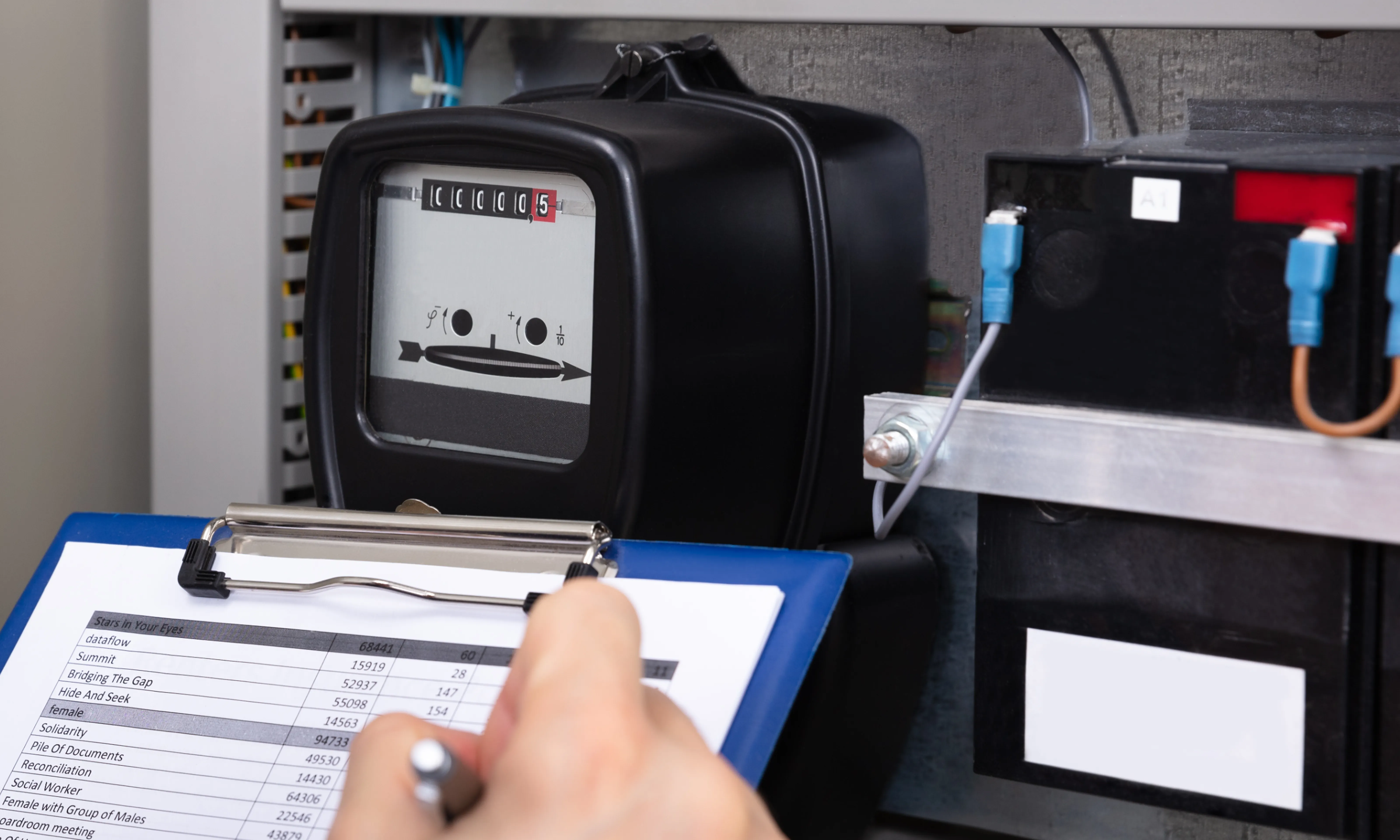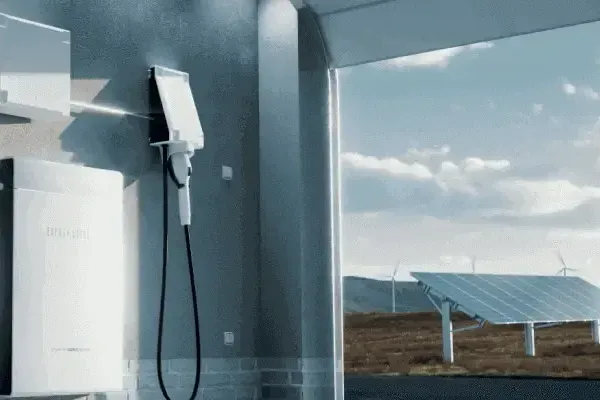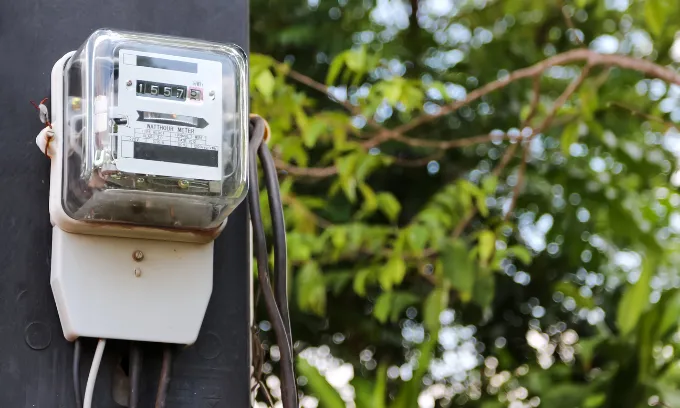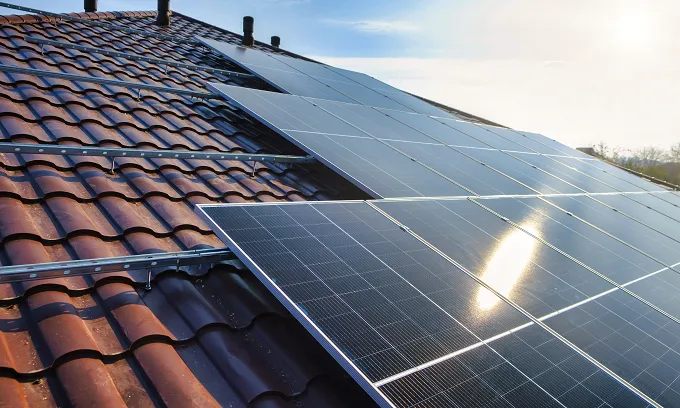Types of electricity meters in Australia
There are three main types of electricity meters in Australia, and the type of meter you have can have a huge impact on your energy costs – and your wallet. The types of electricity meters in Australia are:
- Smart meter
- Accumulation meter
- Interval meter
Accumulation meters explained
Accumulation meters, also known as basic or flat electricity meters, measure how much electricity has been consumed by your property over a period of time.
Accumulation meters can’t tell exactly when electricity has been used, so customers are charged the same rate for electricity regardless of the time of day that power is used.
Customers may also choose a ‘block rate tariff’ depending on the distributor. On a block rate tariff, gas usage is charged differently based on how much gas (measured in blocks) you've used.
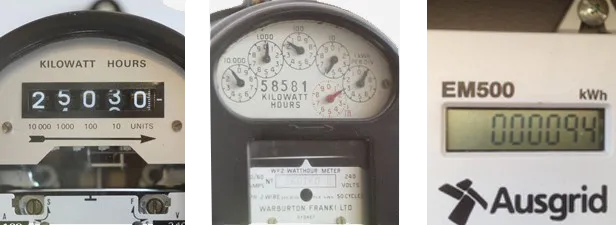
Source: Ausgrid
How to read an accumulation meter
There are three types of accumulation meter displays (pictured above left to right): Cyclometer display, dial display and digital display. Digital and cyclometer displays are arguably the easiest to read—the display simply shows how much electricity has been used in kilowatt hours (kWh).
Dial accumulation meters are slightly more complicated. These electricity meters have five small dials numbered 0 to 9. To take a reading, read the numbers each dial hand falls on from left to right. If the hand falls between two numbers, then record the lowest number (unless it falls between 0 and 9, write down 9). The meter dials in the illustration on the right show a consumption of 46,925 kWh. The red dial can be ignored.
Accumulation electricity meters require a meter reader to come to the property every three months to check how much electricity has been used. This is done by calculating the difference between your current and your previous meter reads. Some energy retailers choose to offer monthly billing, in which case you will receive estimated bills between meter reads.
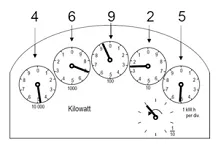
Source: Ausgrid
Interval meters explained
Manually Read Interval Meters (MRIM) record electricity usage every 30 minutes. This means power retailers can charge you different rates depending on the time of day you use electricity.
In this case, you may be charged with a time of use tariff (ToU). ToU tariffs can charge customers low rates during off-peak times, such as late at night. But the trade-off is that you’re charged very high rates during peak demand times, often in the early evening.
Even if you have an interval meter, you can still opt to be charged on a flat rate or block rate if you’re not comfortable with paying different prices for different times of day, but it’s worth discussing this option with your energy provider first, to ensure you’re on the best rate for your usage.
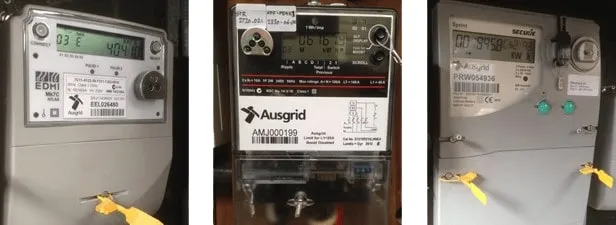
Source: Ausgrid
How to read an interval meter
Interval meters are digital, so they’re pretty straightforward to read. If you want to estimate your next bill, then you’ll need to make a habit of jotting down the kWh figures displayed. Meter readers record interval meter data by attaching an optical probe. This takes the interval meter data and then sends it to the distributor’s systems. The distributor then processes the data up to 10 times to ensure its accuracy before sending it to your retailer for billing.
Smart electricity meters explained
Smart meters, also known as digital meters, provide a more accurate reading of a property’s energy use. They do the following:
- Record your household’s electricity usage in 30-minute intervals by using real-time technology.
- Smart meters send this data wirelessly to your energy retailer.
- This information allows you to receive constant updates on your energy consumption, which can be useful in monitoring usage habits to help save money on power bills.
Customers with a smart meter also have more options when choosing a type of electricity plan. With a smart meter, you can choose between a time of use tariff (ToU) or a single rate tariff, both of which have their pros and cons.
However, if you don’t have a smart meter, you can’t choose a time-of-use electricity plan, which means you won’t be able to tap into cheaper energy rates during the less busy periods of the day, otherwise referred to as peak and off-peak times.
A controlled load, a tariff type that allows power-hungry appliances (e.g. underfloor heating) to draw energy at off-peak hours, is accessible to both smart and non-smart meters if certain conditions are met:
- If you do not have a smart meter: High-usage appliances need to be wired to their own independent meters.
- If you have a smart meter: High-usage appliances must be on different circuits, but fed to the same smart meter.
What are the benefits of a smart meter?
There are numerous benefits to installing a smart meter, such as:
- Transparent billing: Because your energy provider can remotely access your smart meter data in real-time, you’ll be billed exactly for your energy usage.
- Access to live usage information: Some retailers may provide smart meter users with a mobile app or web portal to monitor their energy use. Customers can work out where they’re wasting electricity and how they can save money on future bills.
- Remote disconnection and connection: If you’re moving homes or switching providers, your smart meter can be turned on/off remotely without an on-site electrician — speeding up the process and making it cheaper.
- Flexible rate tariffs: Smart meter users have access to flexible energy pricing, such as a time of use tariff or controlled load tariffs.
- Rooftop solar: A smart meter is required if you’re interested in installing rooftop solar. It also opens you to the world of solar feed-in tariffs and net metering.
- Quicker response to connection issues: With live usage information available, smart meters can also notify electricity distributors of any connection issues as they emerge (e.g. power outages).
- Flexible billing: A smart meter gives you the option to opt for a flexible billing cycle (ie. monthly) instead of quarterly billing.
Reading your smart meter
Unlike a traditional meter, smart meters don't require an in-person meter read. The information from your smart meter still needs to be accessed externally, but this is all done digitally.
This information can be found online by logging into your account with your electricity provider. Some larger retailers, including Origin, AGL and EnergyAustralia will even provide real-time usage information via a mobile app.
If you don’t want to check your mobile device or energy account for real-time updates, you may also be able to install a power usage monitor or an in-home display that can connect to your meter.
Customers in VIC can claim a rebate for these displays as part of the Victorian Energy Upgrade scheme, but those in other states may face a full out-of-pocket cost.
Energy companies that provide real-time usage information
Smart meters provide close to real-time energy usage data, but some electricity retailers and distributors are utilising this information better than others.
If you’re keen to get the most out of your smart meter, the following companies all provide specialised reporting services:
- AGL
- Alinta Energy
- Amber Electric
- Aurora Energy
- AusNet Services
- CitiPower
- EnergyAustralia
- Engie
- Jemena
- Lumo Energy
- Origin
- Powershop
- Red Energy
- United Energy.
Are smart meter readings accurate?
Unlike conventional meter readings, where a contractor would physically record your energy use, smart meters send real-time data to your energy retailer.
Smart meters are comparable to internet banking. Before internet banking, accessing bank account information was only possible via physically attending the bank or calling a teller.
With the arrival of banking apps and the internet, customers can log in to their accounts from digital devices. This is essentially what smart meter technology has achieved with energy – it has given the convenience of monitoring overheads within the comforts of your own home.
Can a smart meter save me money?
While there are no guarantees a smart meter will save money on energy, customers can see live data of energy usage, which can help keep electricity users who are trying to save more accountable.
A smart meter can only save you money if you are willing to adjust your energy usage habits. Here are some examples where a smart meter could help you save money:
Monitoring your energy habits
Because a smart meter records your energy usage in real time, you can map out how and when you’re using the most electricity.
To access your smart meter’s information, you’ll need either your energy provider’s mobile app (if applicable) or a self-installed power usage monitor.
Time-varying tariffs
A smart meter also gives you the option for a time of use (ToU) tariff. If you’re on a ToU tariff, you can prioritise heavier energy use for off-peak hours or shoulder periods, when electricity rates are cheapest. Keep in mind that time-of-use tariffs may end up being more expensive than a flat rate plan if households use the bulk of their electricity during peak hours.
Alternatively, if you have energy-intensive appliances (e.g. a pool pump), you can sign up for a controlled load tariff. These appliances are metered separately at a cheaper rate from the rest of your home. Do take note that their hours of operation will be limited.
Rooftop solar
A smart meter opens you to the world of rooftop solar. If you install a solar system, you can save on future power bills by signing up for a bill credit.
You can also opt for a net metering arrangement, where any solar generation is consumed first at home, before being exported back to the grid.
If you have a solar battery installed, you stand to benefit even more if you’re on a ToU or controlled load tariff. For example, you could store excess solar in the daytime for use during peak hours when electricity is at its most expensive. This stored energy can also be used to power your controlled loads over set hours.
Smart meter installation
If your existing legacy meter breaks, or you’re moving into or building a new property that will connect to the grid, you’ll most likely be offered a smart meter by the retailer supplying electricity to your home. However, retailers are legally prohibited from charging you for the meter or the installation.
Traditional meter users can also request to upgrade their old meters ahead of time by contacting their electricity providers. However, this could incur a fee.
Smart meter eligibility
Not all smart meters are compatible with all homes and energy plans. It is important to confirm which smart meter will work for your home and energy provider before confirming your installation. Here are some things to consider:
- Whether the energy provider offers smart meters with an electricity plan.
- Whether a smart meter is mandatory for a product/service you’ve opted in for (e.g. the installation of new solar panels and/or batteries).
- Whether smart meters have been widely rolled out in your area.
- Whether your existing meter is damaged or faulty and in need of replacement.
- Whether your home is a newly built property.
- Whether your home is part of an embedded electricity network (contact your embedded network operator for more information).
Smart meter installation costs
Because smart meter installation costs vary from provider to provider, it’s important to enquire how they charge for smart meters, as well as any ongoing expenses associated with the device.
Some electricity retailers will bear the smart meter installation costs upfront– including the meter itself– then add a lump sum to the next energy bill or over a few bill cycles.
Other energy retailers may offer free smart meter installation as part of a deal or promotion, but be wary of hidden costs. For example, while the energy retailer may waive installation costs, they could increase their usage rates instead. That’s why it’s vital to always read the fine print on their energy price fact sheets.
Please note that each electricity provider will charge differently for reasons such as the location of service.
How do I organise a smart meter installation?
Before you start, it’s crucial that you first determine if you’re eligible for a smart meter installation. The main factors impacting eligibility are:
- Whether the energy provider offers smart meters with an electricity plan.
- Whether a smart meter is mandatory for a product/service you’ve opted in for (e.g. the installation of new solar panels and/or batteries).
- Whether smart meters have been widely rolled out in your area.
- Whether your existing meter is damaged or faulty and in need of replacement.
- Whether your home is a newly built property.
- Whether your home is part of an embedded electricity network (contact your embedded network operator for more information).
Once you’ve assessed your eligibility, follow the steps below to get your smart meter installed:
- Contact energy providers: Find the most competitive price and whether they are available near you.
- Ask about the costs involved: Find out if there are any installation fees or ongoing expenses.
- Book a date and time: Organise an installation date to replace an existing meter or install a new smart meter.
- Provide safe access for installation: Make sure your energy retailer can safely install your smart meter at the premises:
- Ensure your meter board or housing is not hindered by unsafe wiring.
- Ensure your property has an isolation device for turning off the power.
- Ensure that turning off your power does not impact your neighbours’ access to power.
The availability of smart meters tends to vary between states and energy retailers. However, since December 2017, smart meters have been rolled out for new meter installations or replacements.
In November 2024, The Australian Energy Market Commission (AEMC) also reaffirmed its commitment to the acceleration of smart meter installations across Australia.
How long does it take to receive a smart meter?
Residents of New South Wales, Queensland, South Australia and the ACT should expect around 10 business days for new smart meter connections, and 20 business days for a meter replacement, including solar.
In Victoria, your energy distributor is responsible for all smart meter installations, so it’s best to get in contact.
Which type of electricity meter is best?
If you’re considering building a new home, then you’ll likely be recommended to install a smart meter. In fact, the Australian Energy Market Commission (AEMC) has recommended a 100 per cent uptake of smart meters by 2030, so installing a smart meter now will prevent additional costs to upgrade your meter in the near future.
If you live in a property that’s already built and have an accumulation meter, then it may be worth upgrading your meter if:
- You’re installing solar
- You want a ‘time of use’ tariff
- You want access to live electricity monitoring.
Check with your energy provider to see what’s possible in your location, and then ask about costs. In some states, upgrading your meter can cost anywhere from $250 to $1,000, and the installation process might disrupt your power supply.
If you’re not sure you can front the installation cost, some retailers offer smart meter upgrades that can be repaid incrementally – the cost rolled into your electricity bills.
Electricity meter costs
Every home and business connected to the grid has an electricity meter to record its power use. It’s generally the responsibility of retailers to install, read and maintain these energy meters, depending on where you live in Australia.
Keep in mind that the regulation for metering fees varies considerably across Australia. While this information is correct at the time of writing, regulation and fee schedules are subject to change.
Electricity meter installation cost
For residential properties in South Australia, Tasmania and the Australian Capital Territory, installing a standard electricity meter is usually free. The costs of installing a new meter are typically covered by the supply charge component of your power bills, however, extra fees may apply if you need a non-standard meter (e.g. a three-phase connection).
Victorian customers are charged between $400 and $700 upfront for a single-phase smart meter installation, depending on the distributor.
In Western Australia, a new electricity meter will set households back around $74 to $250, depending on the type of meter and whether it is being connected to a new or existing home.
In New South Wales, customers are also required to fund the cost of the meter and the upfront installation costs. Since meters in New South Wales are supplied by independent retailers instead of distributors, the price of a new meter can vary considerably, so shop around.
Metering service charge
Queenslanders previously had their metering costs covered as part of their supply charge. However, from July 2018, metering costs in the state are now covered by a ‘metering service charge’. This is a separate charge of about 12c/day that appears on customers’ bills under the ‘other charges’ section.
Customers may be required to pay a higher metering service charge for secondary meters, three-phase meters and solar meters. An additional charge is also included for customers who specifically request to disable the modem of their digital meter to prevent it from being read remotely.
Special meter read fee
A special meter reading fee is a charge for having your meter read out of cycle at your own request. Meters are usually read by your retailer every three months (once per quarter) for billing purposes.
If you don’t have a smart meter, someone is required to attend your property to record the electricity usage measured by your meter. These standard meter reads do not incur additional fees.
However, if you require a meter read that is off-cycle, then you could be charged a special meter reading fee. This typically happens if you’re changing retailers halfway through a billing cycle, however it’s less common in recent years.
Other metering fees
Metering fees vary considerably across different networks, so we can’t list them all here. With that said, here are a few other common fees that could apply.
- Meter Inspection Fee: If you’re concerned that your meter is not operating correctly, you can have someone come out to check on it for an additional fee. Any repairs required may also be charged, usually, on a quoted basis.
- Controlled Load Metering Fee: Some meters will require a small upgrade to access controlled load tariffs. If that’s the case, additional fees may apply.
- Connection and Disconnection fee: There could be additional connection and disconnection fees that should be factored in. You can read all about these here.
What do I do if I disagree with a metering charge?
If you disagree with a charge on your power bill, then contact your electricity retailer to find out more. In some cases, they may be able to waive the fee, reduce what you owe, or organise an alternative payment arrangement. It is for this reason that it’s important to find an energy company with great customer service.
Gas meters explained
A gas meter is a device that records natural gas consumption in households and businesses, which is then relayed to individual energy retailers for billing purposes.
A property’s gas usage is measured in megajoules (MJ). Most gas appliances, such as ovens, will detail their energy consumption in terms of megajoules per hour (MJ/h), meaning an oven with an input of 20 MJ/h will use 20 MJs in one hour.
How to read a gas meter
Before reading your gas meter, you’ll need to identify which type of meter your property is connected to – imperial or metric.
As a rule of thumb, an imperial gas meter will have an analog clock face and a metric gas meter will have a digital screen.
Imperial gas meter reading
- Take note of the pointer on each dial and record the numbers from left to right. If a pointer is positioned between two numbers on a dial, always read the lowest number.
- Some old imperial gas meters may have an additional two dials on the top or bottom which are for testing purposes, so disregard them.
- Once you’ve noted the numbers from each dial, you’ll need to convert them from cubic feet into cubic metres, with one cubic metre roughly equal to 35.3ft3.
Metric gas meter reading
- The meter should have a display panel of about eight numbers with M3 (cubic metres) next to it.
- Record each number from left to right, ignoring the numbers in red.
- You’ll need to move the decimal point within the sequence of numbers two spaces to the right. For example, it may read 17.225, which equals 1,722.5M3.
If all of this is too overwhelming, contact your gas provider for support.
How do I find my gas meter number?
Your gas meter number should be listed somewhere on your gas bill, which matches the number that is physically printed on your gas meter.
Typically, your gas meter number will be located on a faceplate in plain sight, either on top or the bottom of the meter.
In NSW, gas meter numbers usually begin with two letters followed by six numbers (e.g. AB123456), while in Victoria, they’ll have four numbers followed by two letters (e.g. 1234AB).
Where is my gas meter located?
- If you live in an apartment, townhouse or a multi-dwelling: Gas meters for every unit are typically centralised in a room in the carpark or basement. Search for the gas meter that corresponds to your unit number. In NSW, your gas meter could be below your kitchen sink.
- If you live in a standalone house: The gas meter should be located outside in your front yard, behind or at the side of your house.
If you still can’t locate your gas meter, reach out to your real-estate agent, body corporate or landlord (if you’re renting) for help.
Why read your gas meter?
Gas meter readings are conducted by a representative every two to three months (depending on your state), sent by your energy distributor who owns and maintains the gas infrastructure in your area. Each bill read is then passed on to your retailer, who bills you for the gas consumed.
However, if you fail to provide safe and clear access to your gas meter, your gas provider will estimate your next bill. This could leave you paying more than you really should.
That’s when reading your gas meter comes into the picture. You could save more by providing your distributor with more accurate gas usage data.
Typically, if a representative fails to conduct a gas meter read safely, they’ll leave behind a gas meter read card in your letterbox that looks like this:
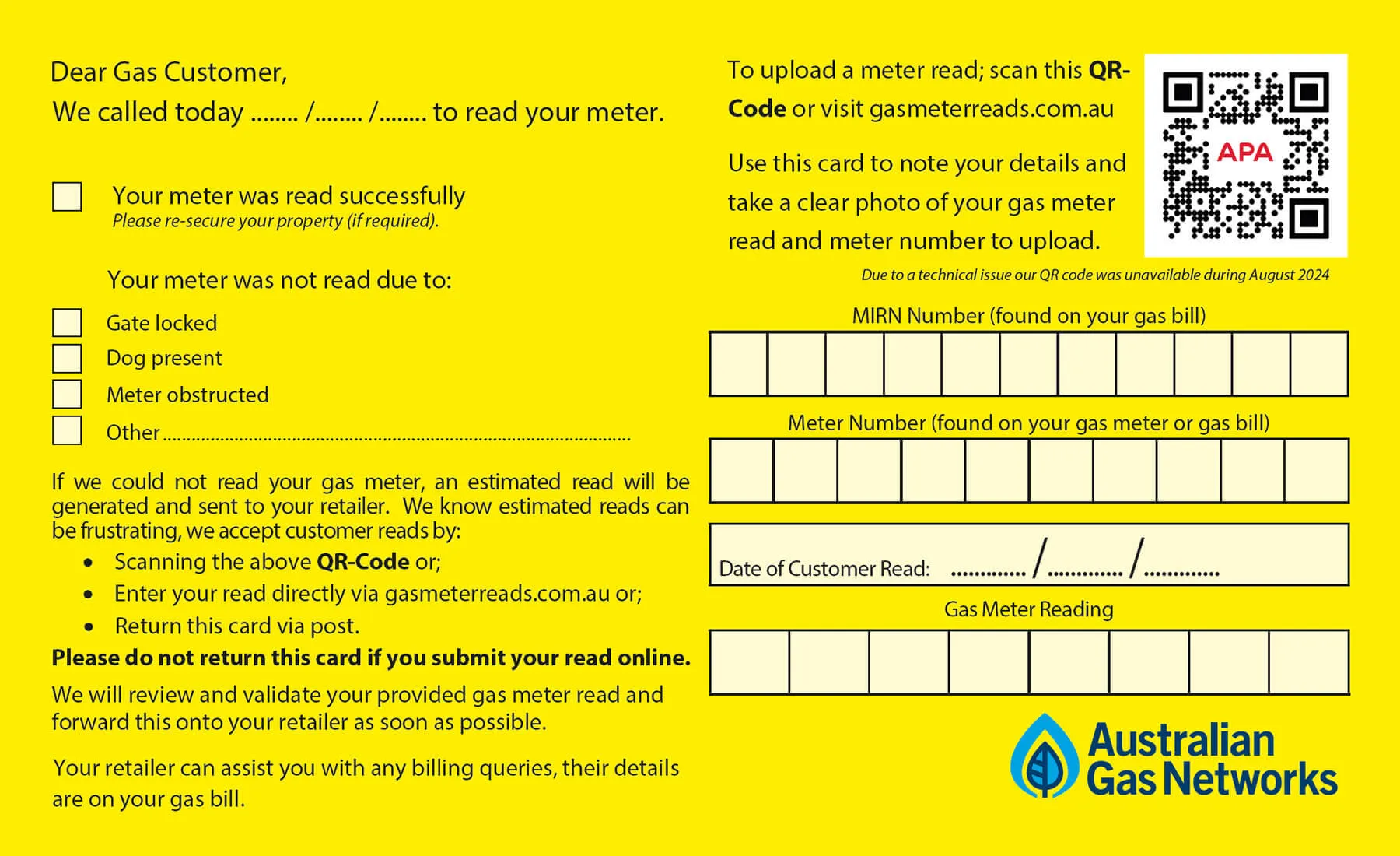
Image: Australian Gas Networks
On this card, you’ll find instructions on how to submit a gas read to the distributor in your area.
All you have to do is populate the card with the required information and submit it through the correct channels:
- Meter number (MIRN)
- Meter Number
- Date of customer read
- Gas Meter Reading
Alternatively, you can also submit your actual read information on your retailer’s website or dedicated smartphone app.
Once your meter reading is done and dusted, remove the original obstruction (e.g. locked gate) or hazard (e.g. unleashed dog) before the scheduled date of the next meter reading, which can be found on your gas bill.
Understanding your gas bill
By having a better understanding of your gas bill, you’ll be able to recognise how much you’re spending and find ways to reduce overall utility costs.
If you’re one of many Aussies who rely on natural gas, it’s worth getting familiar with your meter, just in case you ever need to record a reading after a larger-than-expected bill.
No matter your circumstances, if you haven’t compared gas prices recently, you may be missing out on deals better suited to your budget and needs.
Rather than scanning individual gas supplier websites for plans and prices, use Canstar’s free gas plan comparison tool. You can compare a wide range of gas deals in your area in minutes.
Solar meters explained
If you’ve installed a solar photovoltaic (PV) system or storage battery, then you’ll need a two-way or bidirectional electricity meter that can measure both incoming electricity and solar electricity being exported to the grid in exchange for a ‘feed-in tariff’.
Most modern interval meters are also bidirectional, as are virtually all new smart meters. If you have a dial or cyclometer accumulation electricity meter, however, then you will require a meter upgrade to accurately measure your power exports.
Solar meter installation cost
Solar meter fees in Victoria are often charged upfront in a lump sum, generally costing around $60. Queenslanders, on the other hand, pay for their solar upgrade through a ‘solar meter charge’. This is similar to the metering service charge where customers pay a few cents each day, listed under other charges.



